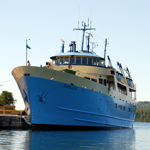
The Ranger III while docked at Isle Royale National Park headquarters. Photo: National Park Service
The Ranger III will ferry passengers to Isle Royale National Park this summer. Thanks to a new ballast water treatment system, invasive species won’t come with them.
The vessel which travels between Houghton, Mich., and the island is the first freshwater ship on the Great Lakes with a permanent system for fighting the spread of invasive species.
Ballast water is pumped on and off ships to stabilize them as they load and unload cargo. Invasive species like zebra mussels and the round goby entered the Great Lakes through ballast water discharge. The annual cost of controlling these species is in the millions of dollars.
Isle Royale park superintendent Phyllis Green recently held a ceremony introducing the ship’s new system of sterilizing ballast water with ultra-violet light after filtering it first.
Captured organisms and pathogens are flushed back into the lake and high intensity UV lamps kill anything that makes it past the filters.
Federal grants from The Great Lakes Restoration Initiative provided money for the system.
New Coast Guard requirements for the treatment of ballast water went into effect June 21. Ocean-going ships are now required to have a permanent system onboard. Though freshwater ships are exempt from the new rules, it doesn’t mean they don’t need them.
Green recently told The Daily Mining Gazette that Isle Royale contains invasive species that haven’t made it to the shores of Michigan’s Upper Peninsula and vice versa.
Glosten Associates, a naval architecture and engineering consultant firm, prepared a report on ballast water treatment systems available for smaller freshwater ships like The Ranger III.
Echo recently reported on the BallastSolution, a treatment system using ultrasound waves to blast apart invasive species.
BallastSolution is designed for use in ocean and fresh water ships.